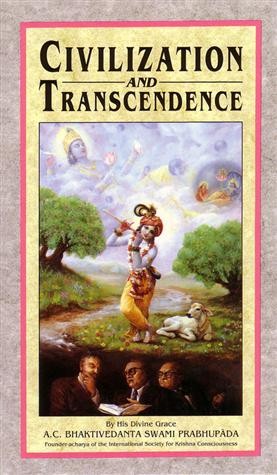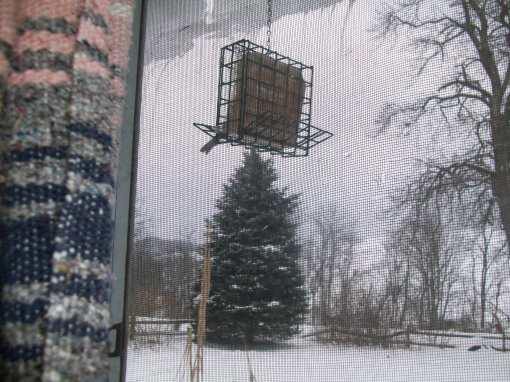Do our impulses come from outside us or inside us?
Is karma yoga practical when even the people for whom we sacrifice consider it insane?
→ The Spiritual Scientist
From Sunil Goel
can you please explain the essence/importance/relativity of NISKAM KARMYOG in this material world where it is treated no more than INSANITY, even by those to whom you do the favour by sacrificing your own self - interests. in that case, how it will be better than fulfilling your own desires and making him a loser instead.....
Why does the Bhagavatam say that we shouldn’t endeavor even for our necessities?
→ The Spiritual Scientist
From: vighnesh kamath
why did in srimad bhagvatam 7.15.16, it is told that we should not even endeavour to earn our livelihood . lord krishna will supply all our basic neccesities automatically . isn't that it is contradicting the karma yoga concept , in which it is said work in krishna consciousness . and normally anyone who works , will work for earning his livelihood only . so shouldnt we even try to earn atleast for maintaining our body and soul together, if not greed . is it not we are triying to run away from our work , and in the name of god, expecting everything will come automatically . is it practical today ? i may have misunderstood the above verse, if yes then in what context it can be reconciled .
ISKCON Leadership Sanga 2014 Begins
→ ISKCON News

The 2014 ISKCON Leadership Sanga (ILS) was inaugurated on February 16 in Sridham Mayapur. Day 1 consisted of three sessions during which at least ten seminars would run in parallel per session. Seminars such as Effective Outreach, How to Implement the 5 Steps of Succession and Identify Future Leaders, Devotee Care Through Cow Care, Invest in the Future, and To Love is to Cooperate were just a handful of the numerous seminars devotees had the opportunity to attend.
Nityananda Trayodasi after abhishek kirtan
→ Gouranga TV - The Hare Krishna video collection
Nityananda Trayodasi after abhishek kirtan
HG Mathuranatha Prabhu – Pastimes of Lord Caitanya Mahaprabhu
→ Kalachandji's Audio Archive
Sri Caitanya Caritamrita: Adi-lila
→ Kalachandji's Audio Archive
Fate Attraction Part 5—Coming to Krishna
→ Karnamrita.das's blog
(this blog is recorded on the full page: quick time player is needed; works best with Firefox or Explorer; if you are using Google Chrome it will automatically play, so to not listen, mute your speakers.)

[I am continuing the reposting of this 5 part series as a way to commemorate this month which marks my 45th year of coming to Krishna. This is the final installment (previously posted 2-16-14)--until I make it into a whole book.] Chris had come back from Muir Woods to Berkeley a few times to restock his food supplies and then return, but this time he felt he would stay in town for a while. He wanted to begin searching the library and alternative newspapers for information about different spiritual orders and groups such as the Trappist monks, Buddhists, and various yoga societies. Somehow to have a new life, a spiritual life, and one by which he could focus on useful life skills, being in harmony with Nature, and helping others.
In his second year of college he wasn’t impressed or inspired by his teachers. He reasoned that if he continued his education he would become like they who were merely part of the materialistic status quo. His teachers didn’t seem interested in changing, becoming better people, or most importantly, in their own souls. Chris felt completely estranged from his old life, apparently lost, even damaged from an external perspective, and yet he felt somehow guided in the process of finding his path. It had been a radical, unpredictable journey and there no end in sight, but his effort to find and live the Truth was worth it, even if his material progress was impeded or lost forever. Without realizing and living the purpose of life, what was the use of any other obtainment, even if praised by the World?
He simplified his life by giving away most of his possessions, and began sleeping on the floor. During the day he would sit on his folded sleeping bag before a small coffee table that he used as a desk. It was covered with stacks of spiritual/religious books, magazines, and notebooks. He dreamed of being a sage or monk, what the I Ching referred to as a “superior man,” not in vanity, but in depth of character. Chris had become a vegetarian rather naturally,
Living With Birds
→ View From a New Vrindaban Ridge
Bird at suet feeder.
Cardinal arriving at sunflower feeder. At times there are as many as 40 birds feeding there including a lot of juncos on holiday from Canada. The snow fence keeps deer and crows from devouring the sunflowers.
We got an inch of snow overnight which I didn’t get around to sweeping off the kitchen steps. By late afternoon it was covered with bird tracks.
Filed under: Cows and Environment
GENIE
→ Gita Coaching
Our Humble Efforts
→ travelingmonk.com
Insectarium
→ TKG Academy
tkg academy students had a fun time at the insectarium.
um is simply dummy text of the printing and typesetting industry. Lorem Ipsum has been the industry’s standard dummy text ever since the 1500s, when an unknown printer took a galley of type and scrambled it to make a type specimen book. It has survived
New Vrindaban Daily darsan @ February 16, 2014.
→ New Vrindaban Brijabasi Spirit
Dressed in a kaupina and kantha, living by eating fruit fallen from the trees, not speaking useless words, not passing the time in useless deeds, abandoning all pride, going to each house to beg a little alms, and following those for whom Sri Radhika is their entire life, I will live in Vrndavana.
[Source : Nectarean Glories of Sri Vrindavana-dhama by Srila Prabodhananda Sarasvati Thakura, 1-64 Translation.]
Preparing Ourselves For Japa
→ Japa Group
I personally reflect on what I need to strengthen in my Japa and make a specific affirmation before I start chanting.
I know some devotees like to make notes about their Japa, normally after their Japa session....notes that they can read over later and reflect on.
If we remain humble, realising that we can always make improvements in our spiritual lives, then we will give ourselves the best chance to make advancement.
From raga to rock!
→ KKSBlog
(Kadamba Kanana Swami, 13 January 2014, Mayapur, India, Lecture: Kirtan Academy 1)
 Kirtan happens on the pure transcendental platform. It is an interesting combination of Krsna’s name and a particular melody, a particular raga, which brings out a mood.
Kirtan happens on the pure transcendental platform. It is an interesting combination of Krsna’s name and a particular melody, a particular raga, which brings out a mood.
It is said that there are sixteen-thousand, one-hundred and eight ragas that are spiritual because there are sixteen-thousand, one-hundred and eight gopis.
Actually every living entity has its own raga, everyone has his own way of singing. Sometimes, we say that some people sing “off” but that is not a fact; they just have their own raga in their own musical scale. So, every living entity has its own raga, the birds have their own raga and all the animals have their own ragas but the sixteen-thousand, one-hundred and eight gopis have their ragas which are spiritual.
So these ragas are known to some in the material world but not to me! I don’t come from a raga background; I come from a rock background and it does happen to me that raga turns into rock – what can I do!? It’s like, somehow or other, it seems to happen to me sometimes but I have always quoted something which is like the Krsna consciousness “Fifth Amendment”:
nāmnām akāri bahudhā nija-sarva-śaktis tatrārpitā niyamitaḥ smaraṇe na kālaḥ etādṛśī tava kṛpā bhagavan mamāpi durdaivam īdṛśam ihājani nānurāgah, (Siksastakam, verse 2)
That basically, there are no hard and fast rules in this chanting so therefore I claim innocence; I am not responsible, rock will do as long as it will connect us to Krsna. Rupa Goswami says that whether it is Vedic or just a practical thing from this world, whatever is favourable for the service of Krsna, is accepted.
HG Nityananda Chandra Prabhu – Summary of the 7th chapter of Bhagavad Gītā H.E.A.D
→ Kalachandji's Audio Archive
HG Deva Darsana Prabhu / SB 10.54.50-52
→ Kalachandji's Audio Archive
HG Narottamananda Prabhu / SB 10.54
→ Kalachandji's Audio Archive
Sanga Friday’s – Caitanya Caritamrta – HG NItyananda Prabhu 2-14
→ Kalachandji's Audio Archive
HG Nityananda Prabhu / Nityananda Trayodasi: Appearance of Sri Nityananda Prabhu
→ Kalachandji's Audio Archive
HG Nityananda Chandra Prabhu – Summary of the 15th chapter of Bhagavad Gītā – H.O.M.E.
→ Kalachandji's Audio Archive
HG Narottamananda Prabhu / Kalachandji’s Bhagavad-Gītā Meditation Course – 14
→ Kalachandji's Audio Archive
HG Cakri Prabhu / SB 02.07.01
→ Kalachandji's Audio Archive
HG Nityānanda Prabhu / The Darshan Room \ The Power of Spiritual Association
→ Kalachandji's Audio Archive
Audio: Vedic Discourse By His Grace Ananda Gauranga Dasa Feb 16 2014
→ ISKCON BRAMPTON
New Vrindaban Amid “Transformation of a Spiritual Community
→ New Vrindaban

By Madhava Smullen
New Vrindaban, ISKCON’s first rural community, is in the midst of a major transformation.
When the community was first established under the guidance of ISKCON Founder Srila Prabhupada in 1968, it became, for many years, a shining example of the best that ISKCON had to offer.
Prabhupada would often direct devotees from other newly emerging communities to study what the devotees at New Vrindaban were doing and to follow their lead in areas such as cow-protection and Deity worship. Meanwhile the cooks, jewelry makers, craftsmen and seamstresses were among the best in ISKCON.
After a series of well-documented legal transgressions and spiritual deviations in the 1980s, however, many devotees left. In 1988, New Vrindaban was excommunicated from ISKCON, and remained so for the next decade. But a dedicated core crew stayed on, navigating difficulties year after year, until in 1998 they brought New Vrindaban to the point where it was once again accepted as part of the broader International Society for Krishna Consciousness.
Although various struggles continued, the community gradually began to be known for its efforts to inspire both ISKCON devotees and the general public, with thousands gathering for its Festival of Inspiration, 24-Hour-Kirtan, and Festival of Colors.
In 2011, nearly twenty-five years since they first started, ISKCON New Vrindaban’s legal and financial crises were finally settled. At last, residents and well-wishers could focus on rebuilding their tarnished and tattered community.
To help, the Board Members and GBC brought in Jaya Krsna Das, who took on the role of community president in March 2011. With twenty-five years of experience in the world of business and seven overseeing major growth at Bhaktivedanta College, Belgium, he used his know-how and a bit of inspiration to develop a strong and effective system for New Vrindaban’s transformation.
The idea for the system took birth when, soon after his arrival, a senior devotee gave him a book entitled ‘One Foot Planted in the Center, The Other Dangling off the Edge: How Intentional Leadership Can Transform Your Church,’ by Gordon R. Dragt. The book tells the story of how one Reverend with a vision turned a New York City church with a history of difficulty into a vibrant and successful community.
“The author explained that it takes seven years to make a change like this,” says Jaya Krsna. “Initially I thought the process would go much quicker. But it has become clear to me that a longer effort is required.”
With this in mind, Jaya Krsna developed a system entitled “Transformation of a Spiritual Community.” It comprises six phases stretching out over a seven-year-period, with each phase lasting approximately one year.
The phases are: Analysis, Change, Transition, Stabilization, Deepening Relationships, and Strong Community Spirit and Unity.
During the first phase, Analysis, Jaya Krsna simply tried to serve the devotees of ISKCON New Vrindaban as best he could, incorporating a principle that Gordon R. Dragt calls “paying the rent,” or recognizing and appreciating the positive achievements of the past before breaking new ground.
“There are many senior devotees here who have given decades of their lives to create a national Tirtha, or holy place—to build the temple, the lodge, the Palace of Gold, the cabins by the water, and the cow protection facilities,” he told ISKCON News in 2011, expressing that he saw himself as simply a small instrument in New Vrindaban’s revival. “They’ve lived very simple lives, and have given everything to Srila Prabhupada.”
He added in 2013, “They have created such an infrastructure and such big potential.”
In the Analysis phase, Jaya Krsna also spent time observing the residents of the New Vrindaban community, seeing how the devotees interacted with each other and where there was room for improvement.
“The analysis phase actually continues throughout all the other phases,” he says. “Because nothing is ever perfect in this material world. So we have to constantly try to adjust and to improve. Not that it’s a one time thing, and then everything is fine. It’s a long process, that you have to constantly work on.”
In the second phase, Change, Jaya Krsna’s aim was to create a dynamic and effective structure for ISKCON New Vrindaban that better reflects the current needs of the community members, tourists and pilgrims.
Part of this involved improving the physical infrastructure of the community. After several decades of minimal to no maintenance, full renovations were carried out on the residential ashrams, restaurant, and the guest lodge. Jaya Krsna also created several new departments, including a facilities department that would handle renovations and construction; a festival department to handle New Vrindaban’s many signature festivals; and a department for devotee care and relations.
The next phase in the transformation was Transition, which ISKCON New Vrindaban is currently still in. Over the past few decades, there had never been enough devotees for the community’s vast infrastructure. So Jaya Krsna brought in several new department heads from countries all over the world, including Mauritius, Switzerland, and of course the USA. As well as overseeing the newly added departments, these devotees take care of the Pujari, Palace Lodge, Restaurant, Land Management, Accounting, Palace of Gold, Ladies’ Ashram, and Congregational Development departments.
Having all these different divisions and their heads is important in the effective running of a large community, Jaya Krsna explains, as it frees up the president to care for devotees, build relationships, provide spiritual support, and plan the future course the community will take.
While it will bring on these positive effects, Transition is also the most difficult phase, with some devotees moving on because they did not feel comfortable or find a place within the new vision.
“The transitional phase has been far from perfect,” Jaya Krishna says, admitting that there was sometimes a lack of communication from his side. “As could be expected, it has been painful for everybody.”
ISKCON New Vrindaban’s 2013 Board Meeting from November 8th to 10th went some way towards soothing this pain. The meeting included an open dialogue during which Board members introduced the new department heads and shared the new “Transformation of a Spiritual Community” system with community members. They also pledged to make devotee care and improvement of community spirit top priorities in 2014.
“Since then, I would say that there has been a strong understanding of all the different phases, and a growing support for them, too,” Jaya Krsna says.
By sometime in 2014, he hopes to have successfully completed the Transitional phase, and to move into Stabilization.
“During the transition, everything is new and fragile,” he explains. “You need a phase to solidify the new structure, so that you know it’s grounded, will not fall apart, and will continue into the future. Stabilization is an important phase during which you go deeper and create a proper team spirit and develop a nice service mood amongst devotees.”
In the fifth phase of the transformation, “Deepening Relationships,” Jaya Krsna hopes that the community members of New Vrindaban will see, based on what was achieved in Stabilization, that the change is not a flash in the pan but is here to stay.
He also hopes that by this point newcomers like himself will have soaked up some of the mood of the holy dhama and be able to exchange with its residents in their “Brijbasi Spirit,” best summed up by Srila Prabhupada in a 1973 letter: “Agriculture and protecting cows, this is the main business of the residents of Vrindaban, and above all simply loving Krishna.”
“Once you have deep relationships, the ultimate goal is Strong Community Spirit and Unity,” Jaya Krsna says. “That’s what everyone is looking for. We are all human beings, we need community and relationships. We want to execute Srila Prabhupada’s instructions for New Vrindaban together, as a strong, unified community.”
Srila Prabhupada, of course, famously gave specific instructions for New Vrindaban, and Jaya Krsna feels that upon reaching the end of the seven phases the community will make significant progress in implementing these instructions and will begin to reveal its seemingly unlimited potential.
“I truly believe that New Vrindaban has incredible potential -- I see it every day,” he says. “Based upon Srila Prabhupada’s Pushpa Samadhi the Palace of Gold, and upon the infrastructure that we have, I think it can once again be one of North America’s leading ISKCON communities.”
ISKCON Leadership Sanga – Day – 01 (Album 84 photos)
→ Dandavats.com
 “For Succession, or where ISKCON will go in the future -- a topic that’s quite popular nowadays -- Bhakti Vijnana Goswami will be giving a talk on The Culture of Empowerment,” says Vrindavan Vinodini. “And in Krishna conscious culture, Bhaktimarga Swami will be offering a drama workshop called Performance Art, giving tips on acting and how to put on dramas.” Read more ›
“For Succession, or where ISKCON will go in the future -- a topic that’s quite popular nowadays -- Bhakti Vijnana Goswami will be giving a talk on The Culture of Empowerment,” says Vrindavan Vinodini. “And in Krishna conscious culture, Bhaktimarga Swami will be offering a drama workshop called Performance Art, giving tips on acting and how to put on dramas.” Read more › Prabhupada Letters :: Anthology 2014-02-16 12:20:00 →
Prabhupada Letters :: 1966
A grand Ratha Yatra through the heart of Mumbai (Album 110 photos)
→ Dandavats.com
 Indradyumna Swami: With a grand Ratha Yatra through the heart of Mumbai and a massive two-day festival in a large park we took our final bows in our 7-week festival tour of India. We pray that Srila Prabhupada has been pleased with our humble efforts to help spread Lord Caitanya's movement in the land of dharma. Read more ›
Indradyumna Swami: With a grand Ratha Yatra through the heart of Mumbai and a massive two-day festival in a large park we took our final bows in our 7-week festival tour of India. We pray that Srila Prabhupada has been pleased with our humble efforts to help spread Lord Caitanya's movement in the land of dharma. Read more › Prabhupada Letters :: Anthology 2014-02-16 12:12:00 →
Prabhupada Letters :: 1968
Prabhupada Letters :: Anthology 2014-02-16 12:05:00 →
Prabhupada Letters :: 1970
Prabhupada Letters :: Anthology 2014-02-16 12:02:00 →
Prabhupada Letters :: 1971
Don’t accept a dependent unless you can deliver him or her from death
→ SivaramaSwami.com
Bhagavatam class in Mayapura.
The post Don’t accept a dependent unless you can deliver him or her from death appeared first on SivaramaSwami.com.
Sri Nityananda Trayodashi 2014 at Iskcon Narasimha Giridhari Mandir, Bangalore (Album 32 photos)
→ Dandavats.com
 Devotees observed fasting until noon on Nityananda Trayodashi. The utsava deities of Sri Sri Gaur Nitai were decorated gorgeously with flowers and tulasi garlands. The beautiful darshan of the brilliantly decorated Gaur Nitai bought joy into the hearts of the assembled devotees, causing a jubilant and enthusiastic kirtan to ensue, thus inspiring everyone to dance in bliss.
A grand ceremonial bath was performed for Sri Sri Gaura-Nitai. The Deities were given a sandal oil massage. After the massage the Deities were bathed with panchagavya which is a combination of milk, curd, sweetened water, ghee and honey. The Deities were then bathed with herbal extracts, scented water, exotic fruit juices, flowers, etc. Read more ›
Devotees observed fasting until noon on Nityananda Trayodashi. The utsava deities of Sri Sri Gaur Nitai were decorated gorgeously with flowers and tulasi garlands. The beautiful darshan of the brilliantly decorated Gaur Nitai bought joy into the hearts of the assembled devotees, causing a jubilant and enthusiastic kirtan to ensue, thus inspiring everyone to dance in bliss.
A grand ceremonial bath was performed for Sri Sri Gaura-Nitai. The Deities were given a sandal oil massage. After the massage the Deities were bathed with panchagavya which is a combination of milk, curd, sweetened water, ghee and honey. The Deities were then bathed with herbal extracts, scented water, exotic fruit juices, flowers, etc. Read more › Prabhupada Letters :: Anthology 2014-02-16 11:57:00 →
Prabhupada Letters :: 1971
Prabhupada Letters :: Anthology 2014-02-16 11:53:00 →
Prabhupada Letters :: 1972
Prabhupada Letters :: Anthology 2014-02-16 11:52:00 →
Prabhupada Letters :: 1972
Prabhupada Letters :: Anthology 2014-02-16 11:47:00 →
Prabhupada Letters :: 1973
Don’t avoid religion just because it has been misused
→ The Spiritual Scientist
Religion might have been misused, but that does not mean that religion should be avoided. Real religion should be taken. Simply because religion has not been properly executed by the so-called priests, that does not mean religion should be rejected. If my eye is giving me some kind of trouble on account of a cataract, that doesn't mean my eye should be plucked out. The cataract should be removed. So that is the idea of the Krsna consciousness movement—to remove the cataract from people's religious vision.
- Srila Prabhupada, Civilization and Transcendence - Replies to a Questionnaire From Bhavan's Journal June 28, 1976













